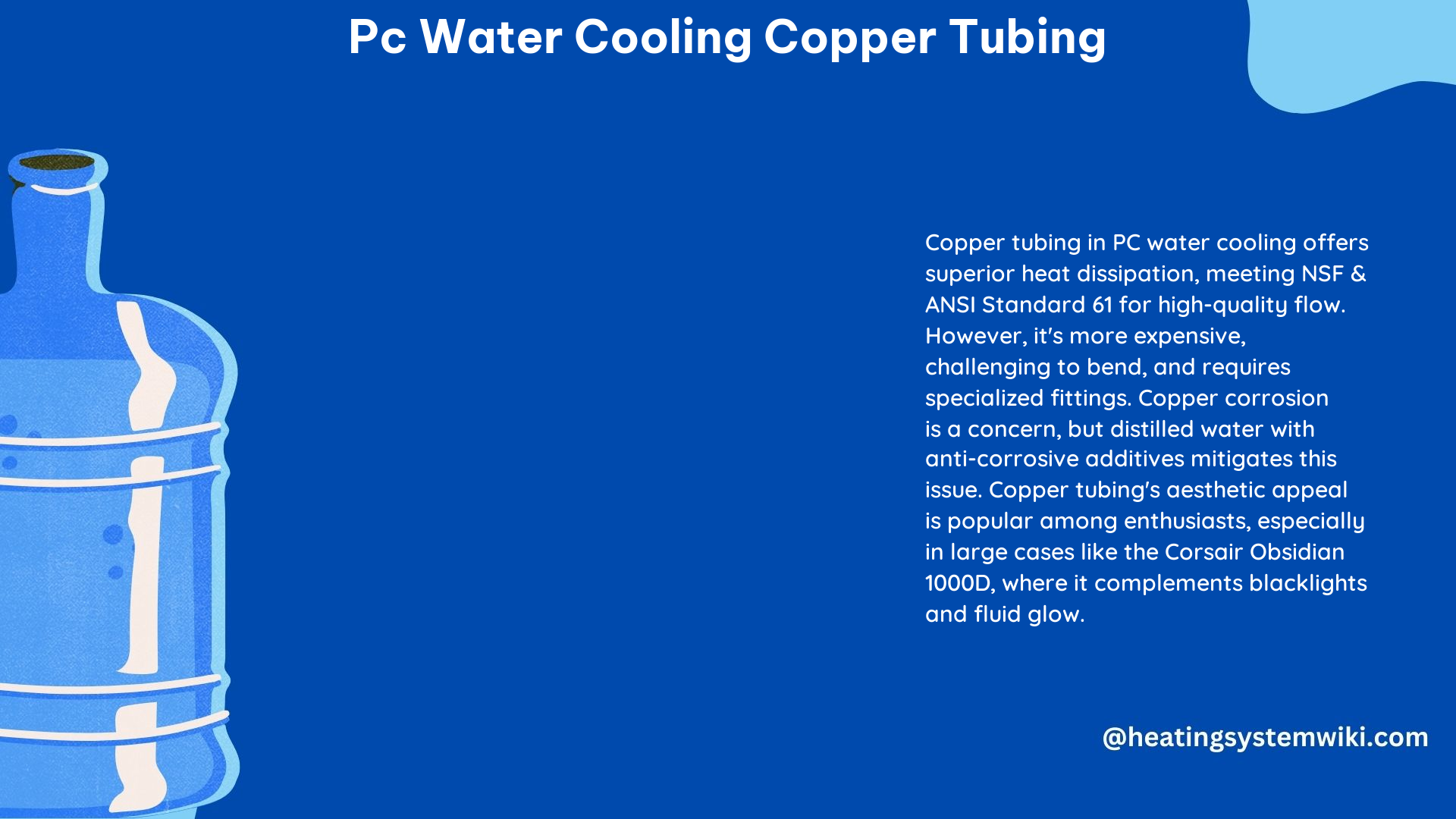PC Water Cooling Copper Tubing offers several advantages over traditional plastic tubing, including improved heat dissipation and a unique aesthetic appeal. Copper tubing is made for water and can be bent easily, making it a viable option for custom water-cooling systems. However, there are some challenges to consider, such as the added cost, potential corrosion issues, and the difficulty of checking flow due to its invisibility.
Advantages of PC Water Cooling Copper Tubing
Superior Heat Dissipation
Copper is an excellent thermal conductor, with a thermal conductivity of approximately 401 W/m·K at 20°C. This means that copper tubing can effectively transfer heat away from the components in your PC, resulting in improved cooling performance and increased system stability.
Unique Aesthetic Appeal
Copper tubing has a distinct, metallic appearance that can add a touch of sophistication and elegance to your custom water-cooling setup. The warm, golden hue of copper can complement a wide range of PC builds, making it a popular choice among DIY enthusiasts and PC builders.
Durability and Flexibility
Copper tubing is highly durable and can withstand the pressure and flow of a water-cooling system. Additionally, copper can be easily bent and shaped, allowing for more creative and intricate tubing layouts within your PC case.
Compatibility with Standard Components
The most common size of PC Water Cooling Copper Tubing is 1/2″ OD (Outside Diameter) with an Inside Diameter (ID) of approximately 0.569″. This size ensures seamless integration with standard liquid cooling components, such as fittings, blocks, and radiators.
Challenges of PC Water Cooling Copper Tubing

Cost
Copper tubing is generally more expensive than traditional plastic tubing, which can be a deterrent for some DIY enthusiasts on a budget.
Potential Corrosion
Copper can be susceptible to corrosion, especially when used in a water-cooling system with dissimilar metals. This can lead to the formation of deposits and potential clogging of the system. Proper maintenance and the use of corrosion inhibitors are essential to mitigate this issue.
Difficulty Checking Flow
The opaque nature of copper tubing makes it challenging to visually inspect the flow of the coolant within the system. This can make it more difficult to troubleshoot any potential issues or blockages.
Technical Specifications of PC Water Cooling Copper Tubing
Tubing Size
As mentioned earlier, the most common size of PC Water Cooling Copper Tubing is 1/2″ OD (Outside Diameter) with an ID (Inside Diameter) of approximately 0.569″. This size ensures compatibility with standard liquid cooling components.
Tubing Material and Construction
The copper tubing used in PC water cooling is typically made of hard-tempered copper, which provides excellent durability and strength. The tubing also meets NSF (National Sanitation Foundation) and ANSI (American National Standards Institute) Standard 61 certification, ensuring high-quality flow and safety for use in potable water systems.
Tubing Availability and Customization
For DIY enthusiasts, companies like Performance-PCs.com offer 1/2″ ID x 5/8″ OD Copper Tubing that is hard-tempered, NSF, and ANSI Standard 61 certified. This tubing is available in various lengths, allowing for customization and flexibility in your water-cooling setup.
Preparing and Installing PC Water Cooling Copper Tubing
Cutting and Bending the Tubing
Copper tubing can be easily cut using a tubing cutter or a hacksaw. When bending the tubing, it’s important to use a bending tool or jig to ensure smooth, consistent bends without kinking or deformation.
Cleaning and Deburring
After cutting the tubing, it’s essential to clean and deburr the ends to remove any sharp edges or burrs that could potentially damage the seals or fittings.
Connecting the Tubing
Copper tubing can be connected to the various components of your water-cooling system using compression fittings. These fittings create a secure, leak-proof seal by compressing the tubing against a ferrule.
Leak Testing
Before filling your water-cooling system with coolant, it’s crucial to perform a thorough leak test to ensure the integrity of your copper tubing connections and the overall system.
Maintenance and Troubleshooting
Periodic Inspection
Regularly inspecting your copper tubing for any signs of corrosion or damage is essential to maintain the long-term performance and reliability of your water-cooling system.
Flushing and Cleaning
Periodically flushing and cleaning your water-cooling system, including the copper tubing, can help remove any buildup of deposits or contaminants that could potentially clog or impede the flow.
Addressing Corrosion
If you notice any signs of corrosion in your copper tubing, it’s important to address the issue promptly. This may involve replacing the affected tubing or using corrosion inhibitors to prevent further deterioration.
By understanding the advantages, challenges, and technical specifications of PC Water Cooling Copper Tubing, as well as the proper installation and maintenance procedures, DIY enthusiasts can create a visually stunning and highly efficient water-cooling system for their PCs.
References:
– YouTube Video: PC Water Cooling Copper Tubing
– Blog Post: Water-Cooled Gaming PC with Custom Copper Tubing
– Performance-PCs.com: PPCS Copper Tubing 5/8in OD 3ft
